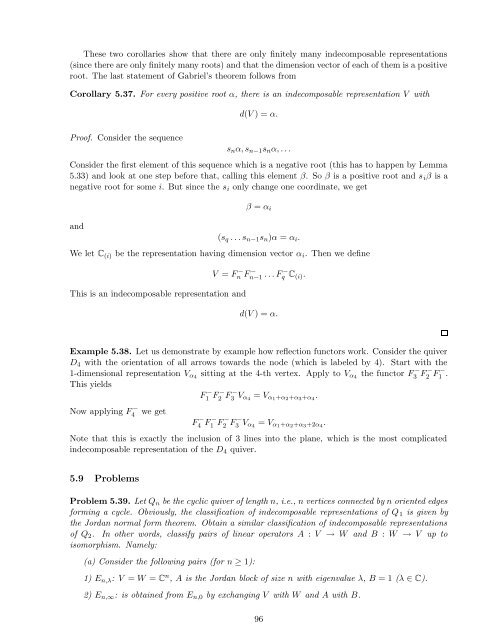Lecture notes for Introduction to Representation Theory
Lecture notes for Introduction to Representation Theory
Lecture notes for Introduction to Representation Theory
You also want an ePaper? Increase the reach of your titles
YUMPU automatically turns print PDFs into web optimized ePapers that Google loves.
These two corollaries show that there are only finitely many indecomposable representations<br />
(since there are only finitely many roots) and that the dimension vec<strong>to</strong>r of each of them is a positive<br />
root. The last statement of Gabriel’s theorem follows from<br />
Corollary 5.37. For every positive root ϕ, there is an indecomposable representation V with<br />
Proof. Consider the sequence<br />
d(V ) = ϕ.<br />
s n ϕ, s n−1 s n ϕ, . . .<br />
Consider the first element of this sequence which is a negative root (this has <strong>to</strong> happen by Lemma<br />
5.33) and look at one step be<strong>for</strong>e that, calling this element α. So α is a positive root and s i α is a<br />
negative root <strong>for</strong> some i. But since the s i only change one coordinate, we get<br />
and<br />
α = ϕ i<br />
(s q . . . s n−1 s n )ϕ = ϕ i .<br />
We let C (i) be the representation having dimension vec<strong>to</strong>r ϕ i . Then we define<br />
This is an indecomposable representation and<br />
V = F n − F n<br />
−<br />
−1 . . . F q − C (i) .<br />
d(V ) = ϕ.<br />
Example 5.38. Let us demonstrate by example how reflection func<strong>to</strong>rs work. Consider the quiver<br />
D 4 with the orientation of all arrows <strong>to</strong>wards the node (which is labeled by 4). Start with the<br />
1-dimensional representation V 4 sitting at the 4-th vertex. Apply <strong>to</strong> V 4 the func<strong>to</strong>r F 3 − F 2 − F 1 − .<br />
This yields<br />
F 1 − F 2 − F 3 − V 4 = V 1 + 2 + 3 + 4<br />
.<br />
Now applying F 4 − we get<br />
F 4 − F 1 − F 2 − F 3 − V 4 = V 1 + 2 + 3 +2 4<br />
.<br />
Note that this is exactly the inclusion of 3 lines in<strong>to</strong> the plane, which is the most complicated<br />
indecomposable representation of the D 4 quiver.<br />
5.9 Problems<br />
Problem 5.39. Let Q n be the cyclic quiver of length n, i.e., n vertices connected by n oriented edges<br />
<strong>for</strong>ming a cycle. Obviously, the classification of indecomposable representations of Q 1 is given by<br />
the Jordan normal <strong>for</strong>m theorem. Obtain a similar classification of indecomposable representations<br />
of Q 2 . In other words, classify pairs of linear opera<strong>to</strong>rs A : V ⊃ W and B : W ⊃ V up <strong>to</strong><br />
isomorphism. Namely:<br />
(a) Consider the following pairs (<strong>for</strong> n ⊂ 1):<br />
1) E n, : V = W = C n , A is the Jordan block of size n with eigenvalue ∂, B = 1 (∂ C).<br />
2) E n,≤ : is obtained from E n,0 by exchanging V with W and A with B.<br />
96

















